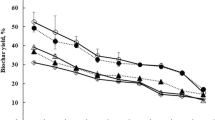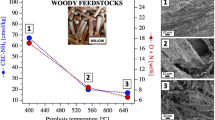Abstract
It was shown that many various biochar types are hydrophobic in low temperature (< 500 °C), but high temperature biochar (> 500 °C) has a tendency of increasing hydrophilicity. Hydrophobicity of low temperature biochar is the most often referred to the effect of pores clogging with tars, since aliphatic compounds vapour only at high temperatures. This research used various methods for the evaluation of biochar wettability, such as the water drop penetration time (WDPT) test, the molarity of an ethanol droplet (MED) test and optical determination of a contact angle (CA). Selection of the best method is difficult because of the fact that many studies used different methods, they have been compared with each other, they refer to different theoretical assumptions and they differ technically. The aim of this article is to compare the three methods used for the evaluation of biochar wettability. The chosen techniques include WDPT, MED and CA measurement. Two different temperatures (450 °C and 700 °C) and two different holding times (1 h and 2 h) were used for the production of different wettability biochar types from five different lignocellulosic feedstocks (pine bark, birch bark, pine wood, birch wood and hemps). Results of wettability and all used techniques overlapped; and this means that it had the same tendency in characterising biochar wettability. Mechanical and practical arguments have been made for the selection of the most suitable method for determination of biochar wettability.







Similar content being viewed by others
References
Werner, S., Katzi, K., Wichern, M., Buekert, A., Steiner, C., Marschner, B.: Agronomic benefits of biochar as a soil amendment after itsuse as waste water filtration medium. Environ. Pollut. 233, 561–568 (2018)
Gwenzi, W., Chaukura, N., Noubactep, C., Mukome, F.N.D.: Biochar-based water treatment systems as a potential low-cost and sustainable technology for clean water provision. J. Environ. Manag. 197, 732–749 (2017)
Duwiejuah, A.B., Cobbina, S.J., Bakobie, N.: Review of eco-friendly biochar used in the removal of trace metals on aqueous phases. Int. J. Environ. Bioremediat. Biodegrad. 5(2), 27–40 (2017)
Rao, M.A., Simeone, G.D.S., Scelza, R., Conte, P.: Biochar based remediation of water and soil contaminated by phenanthrene and pentachlorophenol. Chemosphere 186, 193–201 (2017)
Bubici, S., Korb, J.-P., Kučerik, J., Conte, P.: Evaluation of the surface affinity of water in three biochars using fast field cycling NMR relaxometry. Magn. Reson. Chem. 54, 365–370 (2016)
Dieguez-Alonso, A., Funke, A., Anca-Couce, A., Rombola, A.G., Ojeda, G., Bachmann, J., Behrendt, F.: Towards biochar and hydrochar engineering—influence of process conditions on surface physical and chemical properties, thermal stability, nutrient availability, toxicity and wettability. Energies 11(3), 496 (2018)
Abel, S., Peters, A., Trinks, S., Schonsky, H., Facklam, M., Wessolek, G.: Impact of biochar and hydrochar addition on water retention and water repellency of sandy soil. Geoderma 202–203, 183–191 (2013)
Oliveira, F.R., Patel, A.K., Jaisi, D.P., Adhikari, S., Lu, H., Khanal, S.K.: Environmental application of biochar: current status and perspectives. Bioresour. Technol. 246, 110–122 (2017)
Yang, K., Jiang, Y., Yang, J., Lin, D.: Correlations and adsorption mechanisms of aromatic compounds on biochars produced from various biomass at 700 C. Environ. Pollut. 233, 64–70 (2018)
Hagemann, N., Joseph, S., Schmidt, H.P., Kammann, C.I., Harter, J., Borch, T., Young, R.B., Varga, K., Taherymoosavi, S., Elliott, K.W.: Organic coating on biochar explains its nutrient retention and stimulation of soil fertility. Nat. Commun. 8, 1089 (2017)
Suliman, W., Harsh, J.B., Abu-Lail, N.I., Fortuna, A.-M., Dallmeyer, I., Garcia-Perez, M.: The role of biochar porosity and surface functionality in augmenting hydrologic properties of a sandy soil. Sci. Total Environ. 574, 139–147 (2017)
Zornoza, R., Moreno-Barriga, F., Acosta, J.A., Munoz, M.A., Faz, A.: Stability, nutrient availability and hydrophobicity of biochars derived from manure, crop residues, and municipal solid waste for their use as soil amendments. Chemosphere 144, 122–130 (2016)
Kinney, T.J., Masiello, C.A., Dugan, B., Hockaday, W.C., Dean, M.R., Zygourakis, K., Barnes, R.T.: Hydrologic properties of biochars produced at different temperatures. Biomass Bioenergy 41, 34–43 (2012)
Briggs, C., Breiner, J.M., Graham, R.C.: Physical and chemical properties of Pinus Ponderosa charcoal: implications for soil modification. Soil Sci. 177(4), 263–268 (2012)
Hale, L., Luth, M., Crowley, D.: Biochar characteristics relate to its utility as an alternative soil inoculum carrier to peat and vermiculite. Soil Biol. Chem. 81, 228–235 (2015)
Amonette, J.E.: Letter Report for Characterization of Biochar. Pacific Northwest National Laboratory, Washington (2013)
Jeffery, S., Meinders, M.B.J., Stoof, C.R., Bezemer, T.M., van de Voorde, T.F.J., Mommer, L., van Groenigen, J.W.: Biochar application does not improve the soil hydrological function of a sandy soil. Geoderma 251–252, 47–54 (2015)
Hallet, P. D. (2007): An introduction to soil water repellency, Proceedings of the 8th International Symposium on Adjuvants for Agrochemicals, 6–9 August, Columbus, Ohio, USA
Leelamanie, D.A.L., Karube, J., Yoshida, A.: Characterizing water repellency indices: contact angle and water drop penetration time of hydrophobized sand. Soil Sci. Plant Nutr. 54, 179–187 (2008)
Korenkova, L., Šimkovic, I., Dlapa, P., Jurani, B., Matuš, P.: Identifying the origin of soil water repellency at regional level using multiple soil characteristics: the White Carpathians and Myjavska Pahorkatina Upland case study. Soil Water Resour. 10(2), 78–89 (2015)
Lourenco, S.D.N., Saulick, Y., Zheng, S., Kang, H., Liu, D., Lin, H., Yao, T.: Soil wettability in ground engineering: fundamentals, methods, and applications. Acta peotechnika 13(1), 1–14 (2018)
Olorunfemi, I.E., Ogunrinde, T.A., Fasinmirin, J.T.: Soil hydrophobicity: an overview. J Sci. Res. Rep. 3(8), 1003–1037 (2014)
Baltrėnaitė, E., Baltrėnas, P., Bhatnagar, A., Vilppo, T., Selenius, M., Koistinen, A., Dahl, M., Penttinen, O.-P.: A multicomponent approach to using waste-derived biochar in biofiltration: A case study based on dissimilar types of waste. Int. Biodeter. Biodegr. 119, 565–576 (2017)
Stevenson, W.: Evaluating Soaking Times on the Hydrophobicity of Biochar Using the Water Droplet Penetration Time Method. University of Amsterdam, The soil fertility project (2016)
Page-Dumroese, D.S., Robichaud, P.R., Brown, R.E., Tirocke, J.M.: Water repellency of two forest soils after biochar addition. Am. Soc. Agric. Biol. Eng. 58(2), 335–342 (2015)
Biria, D., Maghsoudi, E., Roostaazad, R.: Application of biosurfactants to wettability alteration and IFT reduction in enhanced oil recovery from oil-wet carbonates. Pet. Sci. Technol. 32(12), 1259–1267 (2013)
Shang, J., Flury, M., Harsh, J.B., Zollars, R.L.: Comparison of different methods to measure contact angles of soil colloids. J. Colloid Interface Sci. 328(2), 299–307 (2008)
Shariff, A., Aziz, N.S.M., Saleh, N.M., Ruzali, N.S.I.: The effect of feedstock type and slow pyrolysis temperature on biochar yield from coconut wastes. Int. J. Chem. Mol. Eng. 10(12), 1410–1414 (2016)
Tripathi, M., Sahu, J.N., Ganesan, P.: Effect of process parameters on production of biochar from biomass waste through pyrolysis: a review. Renew. Sustain. Energy Rev. 55, 467–481 (2016)
Ojeda, G., Mattana, S., Avila, A., Alcaniz, J.M., Volkmann, M., Bachmann, J.: Are soil-water functions affected by biochar application? Geoderma 49, 1–11 (2015)
Liu, Z., Dugan, B., Masiello, C.A., Gonnermann, H.M.: Biochar particle size, shape, and porosity act together to influence soil water properties. PLoS ONE 12(6), e0179079 (2017)
Das, O., Sarmah, A.K.: The love-hate relationship of pyrolysis biochar and water: a perspective. Sci. Total Environ. 512–513, 682–685 (2015)
Aller, D., Rathke, S., Laird, D., Cruse, R., Hatfield, J.: Impacts of fresh and aged biochars on plant available water use efficiency. Geoderma 307, 114–121 (2017)
Raisanen, T., Anthanassiadis, D.: Basic chemical composition of the biomass components of pine, spruce and birch. For. Refin. 31, 4 (2013)
Pettersen, R.C.: The chemical composition of wood. Chem. Solid Wood 207(2), 57–126 (1984)
Moghaddam, M. S.: Wettability of modified wood, doctoral thesis, KTH Royal Institute of Technology, Stockholm (2015)
Bekhta, P., Krystofiak, T.: The influence of short-term thermo-mechanical densification on the surface wettability of wood veneers. Maderas Cienc Technol. 18(1), 79–90 (2016)
Bryne, L. E.: Aspects on wettability and surface composition of modified wood. Licentiate Thesis, KTH-Stockholm, Sweden (2008)
Laschimke, R.: Investigation of the wetting behaviour of natural lignin—a contribution to the cohesion theory of water transport in plant. Thermochim. Acta 151, 35–56 (1989)
Mantanis, G.I., Young, R.A.: Wetting of wood. Wood Sci. Technol. 31, 339–353 (1997)
Yang, G., Jaakkola, P.: Wood Chemistry and Isolation of Extractives from Wood. Saimaa university of applied sciences, Literature study for BIOTULI project (2011)
Graca, J.: Suberin: the biopolyester at the frontier of plants. Front. Chem. 3, 62 (2015)
Thomsen, A.B., Rasmussen, S., Bohn, V., Nielsen, K.V., Thygesen, A.: Hemp Raw Materials: The Effect of Cultivar, Growth Conditions and Pretreatment on the Chemical Composition of the Fibres. Risø National Laboratory, Roskilde (2005)
Bontchev, R.; Kim, H. S.; Wilson, R. W.; Belcher, R. W.; Cheyne, C.; Manzer, L. E.; Jarand, M. L.; Wan. H.; Malyala, R.: 2016 12 22. Enhanced biochar. US patent No. 62/162, 219
Author information
Authors and Affiliations
Corresponding author
Additional information
Publisher's Note
Springer Nature remains neutral with regard to jurisdictional claims in published maps and institutional affiliations.
Rights and permissions
About this article
Cite this article
Usevičiūtė, L., Baltrėnaitė, E. Methods for Determining Lignocellulosic Biochar Wettability. Waste Biomass Valor 11, 4457–4468 (2020). https://doi.org/10.1007/s12649-019-00713-x
Received:
Accepted:
Published:
Issue Date:
DOI: https://doi.org/10.1007/s12649-019-00713-x




